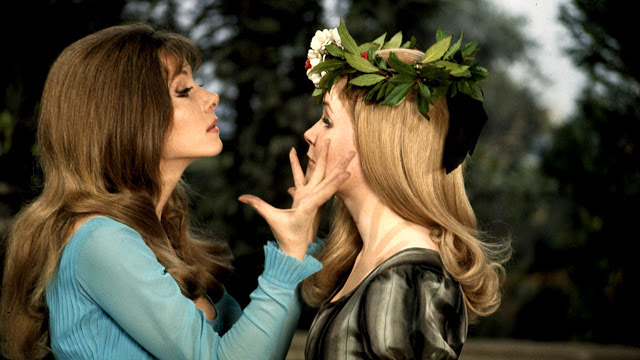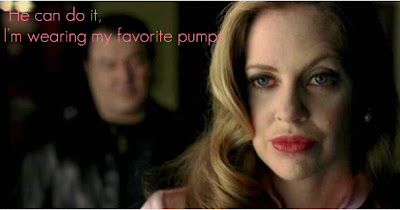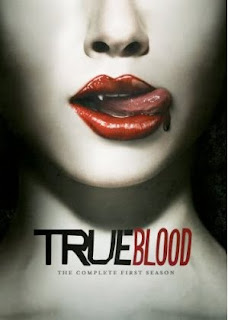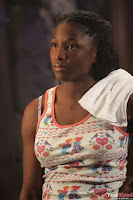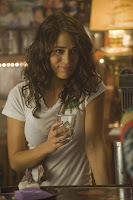 |
| The Vampire Lovers | L-R: Carmilla (Ingrid Pitts) and Laura (Pippa Steel) |
Guest post written by Lauren Chance.
It is a truth universally acknowledged that any fandom, genre or medium must be in want of some lesbians and lo, the so-called ‘lesbian vampire’ genre that exists as a subsidiary to the vampire mythology is here to theoretically do what all lesbian sub-genres inevitably exist for. Horror, to speak generally, is created by men for men and vampires, with their sexual connotations and otherness are arguably the finest example of the masculine expression of the dominant male — one that kills as it penetrates and, as Bram Stoker would have it, infects the mind of the innocent, virtuous and above all else, stupid female.
The lesbian vampire is something of an anomaly though. Rather than being an offshoot of an established genre, it was created alongside the mainstream vampire genre as we know it today. Carmilla, the story upon which The Vampire Lovers (1970) was based, was by no means the first example of vampire fiction, however, it was amongst the very early entries into what was to become an extremely saturated genre. It predates Dracula by twenty-five years and the lyrical ballad from which Le Fanu purportedly took influence was written by Coleridge in 1797… which does predate John Polidori’s The Vampyre — the first established vampire text — by over twenty years.
Which is a roundabout way of saying that the lesbian vampire genre arguably came first in terms of coherent narratives about vampires. But why so much context only to discuss a minor entry into the canon of vampire filmography? Purely because The Vampire Lovers, above all other films with a strong Sapphic vampire plot best embodies the unashamedly sexual aspects of the story and the spirit of intriguing intimacy that Le Fanu put into his text.
 |
| Carmilla (Ingrid Pitt) in The Vampire Lovers |
In both the novella and The Vampire Lovers, Carmilla exclusively stalks female victims, showing little interest in the male characters as anything other than fodder or a means to an end; Ingrid Pitt’s Carmilla never looks quite as comfortable with the lone male in the film she interacts with in a sexual manner as she does with the various women she seduces and bites. As an acting choice it works wonders towards directing a great deal of the interest and sympathy in the film firmly towards Carmilla, rather than the largely inconsequential male lead who is filmed as a somewhat heroic lead but, as with all of the male characters, is filmed as if we should have no reason to be interested in them: there is no doubt that Ingrid Pitt and Carmilla are the stars of this film, regardless of Peter Cushing’s presence.
The Vampire Lovers was the first of the Karnstein Trilogy and as time went on the lesbian subtext dwindled significantly despite the second film also being based on Carmilla, however, there is a very telling difference between Yutte Stensgaard’s almost indifferent attitude to the other women in the cast and eventually her love for a human man in Lust for a Vampire (1971) and the loving, tender way Ingrid Pitt approaches her three primary victims. Pitt’s Carmilla caresses them in their beds, kisses them with obvious intention, undresses them and gazes adoringly at her chosen prey until it is hers. The girls are shown reclining, receptive, vulnerable, eternally dressed in white at night and pastel colours during the day. Laura is peaches and cream English, perfect and untouched and within the first twenty minutes of the film we see in a microcosm how Carmilla operates. She finds a way into Laura’s home, befriends her, touches her as a lover would and then begins to slowly drain the life out of her: mostly, it has to be noted, by biting her breasts. Their bond is such that the male characters don’t even register that it could be problematic. Laura’s father comments that “Laura seems devoted to her [Carmilla].” At the first grand ball where Carmilla first spots Laura, Karl dismisses his intended’s suggestion that the mysterious woman is interested in him and instead insists “Nonsense, she’s looking at you.” No one ever comments upon why Carmilla is looking at Laura. As Laura deteriorates though her reliance and devotion to Carmilla, or Mircarla as this household know her, begins to cause strife amongst the men, her father and the Doctor are helpless in the face of Laura’s bond with Carmilla.
 |
| L-R: Carmilla (Ingrid Pitt) and Laura (Pippa Steel) in The Vampire Lovers |
It is interesting that there is no indication that Laura holds any lasting interest for Carmilla. The vampire moves on with her mysterious – and never explained – Aunt/Countess and is soon in place in the household of Laura’s long-distance friend, Emma. Carmilla’s cycle begins again.
 |
| L-R: Emma (Madeline Smith) and Marcilla (Ingrid Pitt) in The Vampire Lovers |
The film can be neatly cut up into three sections. The first is Laura’s and the final section involves the male characters delving into the Karnstein history and trying to discover Carmilla’s tomb. However, the second section, by far the most engrossing, is very curious in that it could quite easily come from any romance. As with Le Fanu and Carmilla’s predecessor, Coleridge’s Christabel, there are fewer mentions of vampiric activity and Carmilla’s affection for Emma are much more dominant in the narrative than her true nature. What makes The Vampire Lovers such an intensely curious film is that one would imagine the lesbian scenes would be exploitative and, if not crude, then certainly unnecessarily over-the-top. However, this is not the case and I respectfully doff my cap at Hammer Horror and director Roy Baker.
The usual calling cards of Hammer Horror are straightforward: a fairly basic plotline, a “repertory”-esque cast of actors, interchangeably buxom women who meet theoretically grisly but aesthetically titillating ends and the sense that the whole thing is one big joke that everybody, from the actors to the audience are in on. Now, please don’t misunderstand me. This author loves a bit of nonsensical horror romping as much as the next discerning viewer. But there’s no getting around the fact that the Hammer productions were not great works of art; they could in fact be better described as a kind of soft-core horror pornography, filled with fire-engine red blood and more nudity that one would strictly need in a story that was ostensibly about a preying vampire. And yet the two most notably sexual scenarios in the film are directed with a great deal of grace and merit. In both situations Ingrid Pitt has long since lost any clothes she began with (at no point does she ever seemed perturbed about her general state of undress) and Carmilla is preparing to utterly seduce someone.
 |
| The Vampire Lovers |
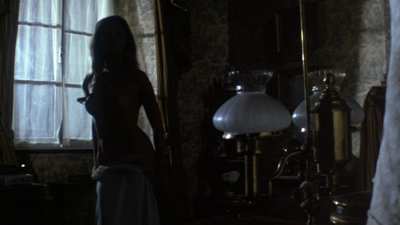 |
| The Vampire Lovers |
There is a softly lit air of concealment to the first scene and a rather more obvious silhouette to the second, however, it would be difficult to argue that though the scenes are sexual in nature, they aren’t presented through the “male gaze.” These women aren’t entering into carnal pleasures that they inexplicably have every knowledge of already and are therefore able to put on a show for the gratification of others; indeed the appreciation of Carmilla is seen in the faces of the female characters and it is with tentative exploration that they approach the mysterious woman.
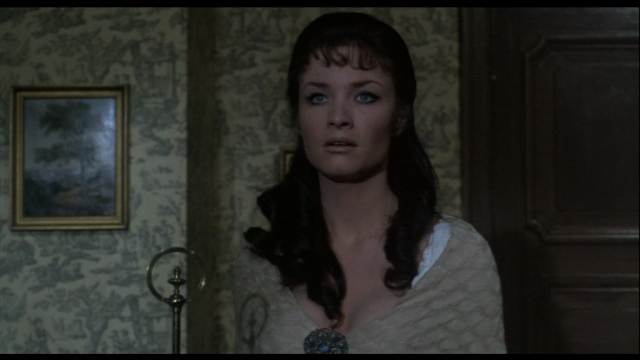 |
| Mme. Perrodot (Kate O’Mara) in The Vampire Lovers |
Arguably, as with any interpretation of vampire texts, one could say that Carmilla is preying upon victims who simply don’t understand what is happening to them. The taking of blood by an unnatural source from a girl on the cusp of womanhood who, tellingly, has no mother to guide her through puberty is a parallel too obvious to explore at length. But one could argue that when Carmilla kisses Laura, her intended victim perhaps doesn’t notice that there is anything extraordinary in the embrace and thus succumbs to it. On the other hand Emma can have been left in very little doubt of Carmilla’s intentions when the vampire declares her love and insists, “I don’t want anyone to take you away from me.” There is emotion behind Carmilla’s desire for Emma that does not simply extend to the carnal and Pitt and Baker use every opportunity to fill the screen with longing looks and claustrophobic framing of the two women — Emma and Carmilla are never especially far from each other.
Inevitably though Carmilla must die. But, as befitting of The Vampire Lovers, in which a multitude of things regarding Emma and Carmilla’s intimate relationship are allowed to go unsaid and unmentioned by the other characters, there is the clear suggestion that Emma is not entirely rid of Carmilla’s influence. At the moment of the vampire’s final death, Emma is languishing in her bed, having been saved by Karl and despite her safety, she cries out in horror when the final blow is struck.
 |
| Emma (Madeline Smith) in The Vampire Lovers |
It is very telling that the final moment in the film is a hint that the deep nature of their relationship is something the men cannot sever and neither can they entirely take Emma away from Carmilla now that she has had her. The lesbian vampire sub-genre as we know it today has suffered serious set-backs since The Vampire Lovers, which seems a thoroughly unlikely thing to say when one considers that it was made over forty years ago now. However, there is a single-mindedness to Pitt’s Carmilla that makes her enthralling for the audience and a certain tone of her performance that lifts the character out of being gratuitous with her lusts and desires. She wants Emma and she intends to have her, there is no debate over what the men think of the situation, no snide jokes that are there entirely to belittle the female relationship. In portraying the men as being entirely ignorant, Baker allows the audience to see the relationship from Carmilla and Emma’s perspective. Their touches are not always sexual, but sensual instead, the kisses not entirely chaste but always intimate and above all else the love Carmilla has for Emma is entirely between them with no one else ever being aware of it.
———-
Lauren Chance has a Masters in English Literature and lives in London, carefully avoiding that horrible and impossible moment when one grows tired of the City and existence at the same time. She had written on Daphne du Maurier most recently and a number of other things during her colourful experience at Queen Mary, University of London. She is particularly interested in biopics at the moment and hopes one will shortly be made about Ingrid Pitt. You can follow her tumblr at
http://crackalley.tumblr.com/.





